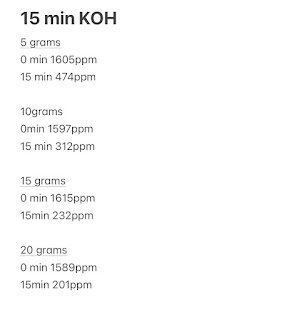Ingrid's Day 5 Sr.Project
Ingrid Wu's Day 5 Blog
May 12 2023
KOH
I bought another chemical today to see if chemicals other than Ca(OH)2 can also work as a catalyst in CCS process. Potassium Hydroxide (KOH) is also a strong base as Ca(OH)2, but different than Ca(OH)2, KOH is soluble to water. This part of the characteristic will solve the problem that I encountered yesterday. Ca(OH)2 always precipitate at the bottom of my container, which may affects its effectiveness in my study. When KOH can be fully dissolved in water, I will not need to worry about whether the solution will be fully performed in the sequestration process.
Also, from my research I learned that KOH is more easy to handle with, as it will not cause breath irritation as long as proper protections is used. Unlike Ca(OH)2, the solution of it may form a film that is hard to remove on hand or in the container.
Today, I ran a few tests to see whether KOH will work as I expected in decreasing CO2 in a closed certain area. The area that I tested has the dimension of 60.9*42.69*33.14 cm.
First, I ran a control test. Different than the one as I did in the Day 1, I did the control test with the air pump pumping air in the box without chemicals. As the data shown below, the decrease is not significant, dropping from 1403 ppm to 1295 ppm in 10 minutes.
Then, I ran a test to see whether KOH will work. 5 grams of KOH is dissolved in 2L of water and the box was ran for 50 minutes. Gladly, it worked, the CO2 level dropping from 1391 ppm to 201 ppm.I also want to test whether the concentration of KOH in the water will affect the CSS performance, especially when KOH doesn't precipitate, so I ran another two tests with 5 grams of KOH and 10 grams of KOH accordingly. However, from the decrease, I couldn't give a proper conclusion that the amount of KOH will affect the Carbon capture effectiveness, but I will retest this again tomorrow.
Total hour: 36h




Comments
Post a Comment